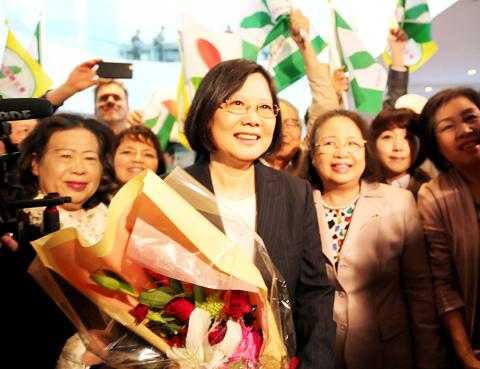Democratic Progressive Party (DPP) presidential candidate Tsai Ing-wen (蔡英文) yesterday arrived in Tokyo on a visit to meet with friends and Taiwanese expatriates.
Upon arrival at Haneda Airport, Tsai was greeted by a group of her supporters, Taiwanese Representative to Japan Shen Ssu-tsun (沈斯淳) and members of the Japanese media.
Her four-day trip, which she has dubbed a “Taiwan-Japan friendship tour,” is aimed at meeting friends and visiting Taiwanese expatriate communities ahead of next year’s Jan. 16 presidential election, she said in response to questions from Japanese media.

Photo: CNA
Tsai said she also hopes to meet with people in Japan who are familiar with the nation’s efforts to cope with the challenges of globalization and to talk with leaders in the industrial sector about possible cooperation in economic and industrial areas.
Given the opportunity, Tsai said she would also like to exchange ideas with members of Japan’s two main political parties and others in the political arena.
Tsai is leading by a wide margin in public opinion polls and is seen in some quarters as poised to become the nation’s first female president.
Regarding reports that the Chinese Nationalist Party’s (KMT) upper echelon has discussed with its presidential candidate, Hung Hsiu-chu (洪秀柱), growing calls for Hung to drop out of the race due to her low level of support, Tsai said that it would be inappropriate for her to comment on the matter, as it is a KMT internal issue.
However, she added that “what people want to see is a stable political party and a reliable team, and what Taiwanese have seen recently is that the DPP is a stable political party and a reliable team.”
Additional reporting by Su Fang-ho

SHIPS, TRAINS AND AUTOMOBILES: The ministry has announced changes to varied transportation industries taking effect soon, with a number of effects for passengers Beginning next month, the post office is canceling signature upon delivery and written inquiry services for international registered small packets in accordance with the new policy of the Universal Postal Union, the Ministry of Transportation and Communications said yesterday. The new policy does not apply to packets that are to be delivered to China, the ministry said. Senders of international registered small packets would receive a NT$10 rebate on postage if the packets are sent from Jan. 1 to March 31, it added. The ministry said that three other policies are also scheduled to take effect next month. International cruise ship operators

HORROR STORIES: One victim recounted not realizing they had been stabbed and seeing people bleeding, while another recalled breaking down in tears after fleeing A man on Friday died after he tried to fight the knife-wielding suspect who went on a stabbing spree near two of Taipei’s busiest metro stations, Taipei Mayor Chiang Wan-an (蔣萬安) said. The 57-year-old man, identified by his family name, Yu (余), encountered the suspect at Exit M7 of Taipei Main Station and immediately tried to stop him, but was fatally wounded and later died, Chiang said, calling the incident “heartbreaking.” Yu’s family would receive at least NT$5 million (US$158,584) in compensation through the Taipei Rapid Transit Corp’s (TRTC) insurance coverage, he said after convening an emergency security response meeting yesterday morning. National

PLANNED: The suspect visited the crime scene before the killings, seeking information on how to access the roof, and had extensively researched a 2014 stabbing incident The suspect in a stabbing attack that killed three people and injured 11 in Taipei on Friday had planned the assault and set fires at other locations earlier in the day, law enforcement officials said yesterday. National Police Agency (NPA) Director-General Chang Jung-hsin (張榮興) said the suspect, a 27-year-old man named Chang Wen (張文), began the attacks at 3:40pm, first setting off smoke bombs on a road, damaging cars and motorbikes. Earlier, Chang Wen set fire to a rental room where he was staying on Gongyuan Road in Zhongzheng District (中正), Chang Jung-hsin said. The suspect later threw smoke grenades near two exits

The Forestry and Nature Conservation Agency yesterday launched a gift box to market honey “certified by a Formosan black bear” in appreciation of a beekeeper’s amicable interaction with a honey-thieving bear. Beekeeper Chih Ming-chen (池明鎮) in January inspected his bee farm in Hualien County’s Jhuosi Township (卓溪) and found that more than 20 beehives had been destroyed and many hives were eaten, with bear droppings and paw prints near the destroyed hives, the agency said. Chih returned to the farm to move the remaining beehives away that evening when he encountered a Formosan black bear only 20m away, the agency said. The bear